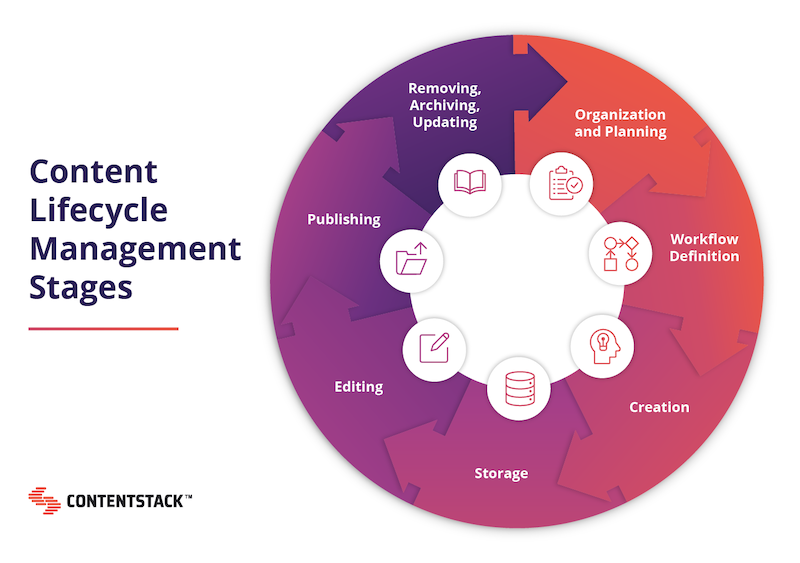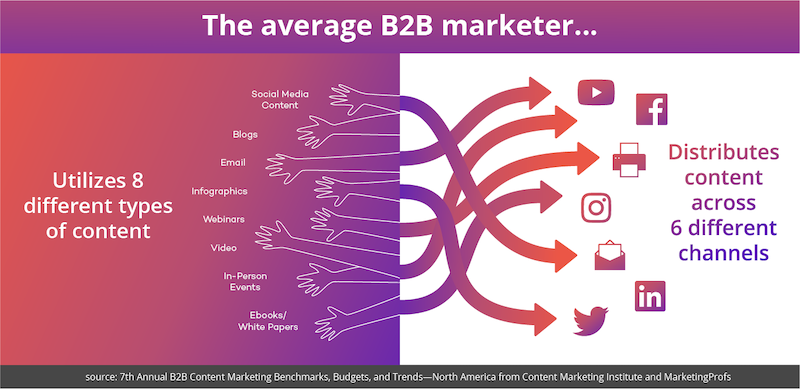Content Lifecycle Management for the Modern Enterprise

Contentstack recently hosted the first of a three-part webinar series titled “How to Make Content Marketing Work for You,” in which Tim “The Doctor” Walters from The Content Advisory walks businesses through executing content strategies that have tangible results. And he should know, considering that The Content Advisory has helped brands such as Capital One, Hilton, Dell, and Caterpillar transform their marketing content into unforgettable customer experiences!
This webinar, along with the rest of this article covering every stage of content lifecycle management, is sure to give you valuable insights into building successful team structures, content models, and processes for the creation, management, and iteration of customer-experience-centric content.
What is Content Lifecycle Management?
The complete content lifecycle management is the process of developing, publishing, organizing, and repurposing/retiring content during its lifetime at your organization. Having a content lifecycle management system in place empowers content strategists to effectively oversee and guide any size content program.
And, to pull it all off without a hitch, there are seven stages you’ll want to get familiar with.
The 7 Stages of Content Lifecycle Management
While you may find you need to switch the order of, or even skip, some of these to fit your organization’s unique needs, the following stages should help almost any content strategist build a solid standard operating procedure when it comes to managing content.
1. Strategic Organization and Planning
We’re starting strong with two tasks in one step! Strategic organization is the lifeblood of content management, and it will help you keep track of each piece of content as it moves through its lifecycle.
One of the most critical points Tim “The Doctor” Walters makes in the first “How to Make Content Marketing Work for You” webinar is that strategy is key to success and that resources should never constrain strategic thinking.
Walters also points out that when it comes to content marketing, strategic organization calls for creating an editorial board that is separate from content operations. This board should oversee the entire content marketing ecosystem — from the underlying technologies and services that make it work to the instructions and calendars that guide the content creators. Even the smallest marketing team can develop a board relative to its size to build the foundation and processes to accelerate strategic content evolution.
After establishing a strategy to ensure that your content efforts are ready to move forward, the primary assignment during this step is to develop categories that you’ll use to classify and, later, label your content. Once each category is solidified, you’ll be able to establish guidelines that govern the creation of content in each.
2. Workflow Definition
While this might seem like the shortest stage, you must take your time here. That’s because you’ll be defining your content lifecycle management workflow. This stage involves establishing a plan for how each type of content moves through the lifecycle. It also includes tracking and approvals, such as digital calendars, ticketing systems, or steps in your content management system.
Map out your workflow approvals so you can address any issues when things aren’t going according to plan. Establishing workflow approvals is a double-edged sword. You need to make sure that you get the right approvals for content; however, adding too many levels of approval frequently delays projects. For example, it can impact a workflow if team members change, people get sick, or a person takes time off. Be sure to audit your workflow approvals to make sure that they work smoothly.
3. Creation
The goal in the creation stage is to make it so that anyone involved in content development can pop into your content lifecycle management plan and find everything they need to go from research to a publish-ready product.
While only you know exactly what that includes, here are a few questions you’ll likely want to address:
- Who is responsible for developing content in each stage?
- How long should it take to create the content in each stage?
- Are there recommended resources for content creation in each stage?
- Are there documents that define content style, voice, and best practices?
The most challenging part of this stage will be striking a balance between providing enough detail so creators can autonomously develop content and too many details that will stifle the creative spirit.
4. Storage
Storage may seem tedious, but it must be well thought-out. Namely, you need a naming convention (see what we did there?) that ensures content is searchable, and you can tell its status at a glance.
Additionally, you need a documented “filing” process that anyone can quickly learn and use to find the piece of content they need — no matter where it is in the content lifecycle.
And don’t forget to consider accessibility when it comes to storage. Who can access content when it’s stored? What happens if that person is unavailable? These are questions you want to consider before they come up.
5. Editing
Maintaining consistent, high-quality written content requires consistent, high-quality editing. What can you do to make sure this happens with every single piece of content, every single time? Again, we go back to careful documentation. Make sure your voice, style, grammar, formatting, and other guidance documents (which you probably developed back in the creation phase!) are up to date and easy to find.
6. Publishing
Are you ready for your closeup? We hope so because this is when your content goes live! In this step, you’ll want to create a publishing checklist for each content type: Blogs, videos, infographics, and so on. The best way to create this list? Document every step you’re already taking when you publish something — then test it by having someone with less experience follow your checklist.
7. Removing, Archiving, Updating
Old content doesn’t necessarily have to be put out to pasture. Before you decide to remove or, more likely, archive content — think about how you may be able to refresh it to generate traffic and conversions with minimal resource expenditure.
Here are a few indicators that a piece of content might just need refreshing:
- It still generates engagement
- The message is still valuable to your audience
- All it needs is some fresh research to recharge the value
Sometimes, you do have to say goodbye to outdated content. If a piece checks any of these boxes, it may be time to retire it:
- It no longer accurately represents your brand
- The content has started underperforming — or never really performed well
- The focus of the content is no longer relevant (past software updates, press releases, and news coverage would fall into this category)

Remember that the bigger and more distributed your team, the more critical planning and documentation are to the content lifecycle management process.
Common Challenges in Enterprise Content Lifecycle Management
While nearly 90% of enterprise marketers engage in content marketing, only 28% feel their efforts are effective. That’s a scary thought. What’s going on during the content lifecycle management program that could be causing such a critical breakdown?
Clunky Content Handoff Between Departments
The first issue is one you’ve likely seen or felt as it can happen during any process at any business: a clunky or even nonexistent handoff of important materials.
Having either too much process or no process to speak of are both detrimental to publishing effective content. Too much process quickly leads to overload and intimidation. Too little process leaves people confused about their responsibilities and causes content to stagnate and get lost in the content management flow.

A well-executed handoff system is especially important when it comes to content, as each piece must go through several different sets of hands during its lifetime.
Quality Assurance as Content Passes Through Multiple Hands
The bottleneck is also related to the handoff process. Not only do you need to make sure content is efficiently flowing through your organization, you also need to make sure it’s not losing quality at each stop along the journey.
Unfortunately, when something becomes the responsibility of many different people, it’s hard for any single person to feel fully responsible for its quality. If this issue is springing up at your organization and you don’t want to put all the weight on your editors and publishers, consider placing “checkpoints” at each handoff to ensure consistently high quality.
Creating Content for Multiple Audiences Across Multiple Channels
Today, 86% of digital consumers already switch between at least two different channels when making an online purchase. And, 90% of these consumers expect flawless, consistent experiences across every channel on which they interact with a business.
The good news is that omnichannel shoppers spend an average of 4% more on every in-store shopping trip and 10% more online! The bad news is that 55% of omnichannel shoppers still find the buying experience “disjointed” as they move between channels.
To outperform its competition, the modern enterprise must strive to deliver personalized content to each specific audience — and to do it in a way that’s relevant to and formatted for every channel and device. Frankly, most businesses just don’t have the personpower or the right technology to keep up with that challenge right now.

See your organization reflected in any of these content lifecycle management challenges? If so, we’re ready to help you overcome them.
Technology for Managing Your Content Lifecycle Effectively
The best way to overcome enterprise content lifecycle management challenges? Adopt the right technology for the job.
Team Collaboration Technology
When it comes to the organization and planning, workflow definition, and removing, archiving, and updating stages of content lifecycle management — the most important technology you can put in place is that which helps your team collaborate.
With the rise of distributed offices, there are so many options on the market. Try Google Meet, Jitsi Meet, GoToMeeting, and join.me for virtual meetings and Slack and Microsoft Teams for any communication that needs to happen between meetings. To create, store, and even share notes on essential decisions, check out MindMeister or Minutes.io.
Task Management Platforms
Effective content management relies on each person in the process to complete their role to spec and on time.
Thankfully, there is plenty of software that allows you to define each stage of your content management workflow, assign tasks and due dates in each of these stages, and get an overview of how content is moving through the lifecycle. Asana, Trello, monday.com, and Jira are just a few great options to consider.
A Cutting-Edge Content Management System
When it comes to handling the creation, storage, editing, and publishing stages of the content lifecycle, nothing beats a content management system (CMS). And we’re not talking an old legacy, traditional CMS; we’re talking a headless CMS like Contentstack.
Headless CMS is an agile, modern take on content management. A headless CMS decouples the reader-facing display (the “head”) of the content from the process of creating and storing it (the “body”). Instead of being embedded into the front-end design like it is with a traditional CMS, headless content lives in a content repository from which developers can use application programming interfaces (APIs) to access the content, enabling delivery to any device and any channel.

With a headless CMS, development and design teams are empowered to build out the best-fitting front-end design to make content appear flawlessly while content strategists are creating, optimizing, and publishing content to various channels and devices — all at the same time.
To learn more about the best ways to put headless CMS to work in your content department, download our free eBook: The Ultimate Guide to CMS, vol. 3: Use Cases for Headless Content Management Systems.
Will You Follow Our Guide to Optimize Your Enterprise Content Lifecycle Management?
An optimized content lifecycle management system is critical for the content strategist who wants to create the most effective and most competitive marketing material for their enterprise.
Now that you understand the most prevalent challenges in enterprise content management, the key technology for meeting these challenges, and the steps for creating a program to knock content lifecycle management out of the park — you’re ready to pull off the best marketing content your business has ever seen!
For a free, information-packed, 45-minute lesson on how to make your content marketing more effective, be sure to check out the webinar featuring Tim Walters from The Content Advisory as he walks through the following topics:
- the four most important operating models in modern content marketing,
- how to set up team structures and processes for success,
- how to assess if your organization is ready to deliver customer experiences at scale,
- and helpful recommendations for easing strategic content evolution.
About Contentstack
The Contentstack team comprises highly skilled professionals specializing in product marketing, customer acquisition and retention, and digital marketing strategy. With extensive experience holding senior positions at renowned technology companies across Fortune 500, mid-size, and start-up sectors, our team offers impactful solutions based on diverse backgrounds and extensive industry knowledge.
Contentstack is on a mission to deliver the world’s best digital experiences through a fusion of cutting-edge content management, customer data, personalization, and AI technology. Iconic brands, such as AirFrance KLM, ASICS, Burberry, Mattel, Mitsubishi, and Walmart, depend on the platform to rise above the noise in today's crowded digital markets and gain their competitive edge.
In January 2025, Contentstack proudly secured its first-ever position as a Visionary in the 2025 Gartner® Magic Quadrant™ for Digital Experience Platforms (DXP). Further solidifying its prominent standing, Contentstack was recognized as a Leader in the Forrester Research, Inc. March 2025 report, “The Forrester Wave™: Content Management Systems (CMS), Q1 2025.” Contentstack was the only pure headless provider named as a Leader in the report, which evaluated 13 top CMS providers on 19 criteria for current offering and strategy.
Follow Contentstack on LinkedIn.







.svg?format=pjpg&auto=webp)
.svg?format=pjpg&auto=webp)
.png?format=pjpg&auto=webp)






.png?format=pjpg&auto=webp)


